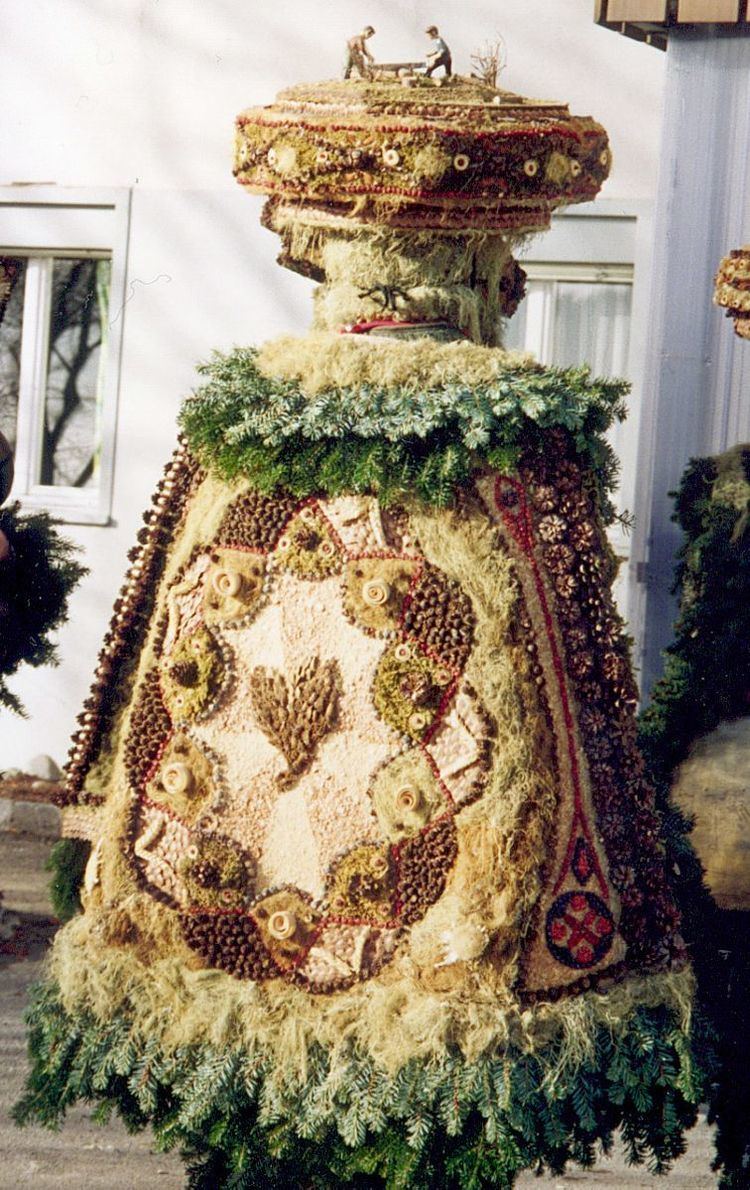 | ||
Silvesterklaus is a masked person taking part in Saint Sylvester's Day festivities in Appenzell, Switzerland, and thus contributing to maintain the «Chlausen» tradition. A Silvesterklaus or New Year’s Mummer («Chlaus» in Swiss German) is dressed up as a Saint Sylvester or New Year’s Eve character. In the Reformed half-canton of Appenzell Ausserrhoden, the turn of the year is still celebrated in this way.
Contents
[This article is a translated adaptation of de:Silvesterklaus German Wikipedia. ]History
Saint Sylvester, or New Year’s Eve is commemorated twice, once according to the Gregorian calendar on 31 December and again according to the Julian calendar on 13 January. The «Silvesterkläuse» put on their strange costumes and, ringing huge bells and singing a very slow yodel, deambulate in small groups from house to house, to wish the people a happy new year. If 31 December or 13 January falls on a Sunday, the ceremony is celebrated on the preceding Saturday.
It is assumed that the «Chlausen» festival does not have pagan origins, but goes back to a late medieval Advent tradition involving students of a monastic school. In the 15th Century, with the celebrations becoming increasingly wild and carnival-like, the Catholic Church must have found that such behaviour hardly befitted the Advent season, which in turn may explain why the «Chlausen» custom was transferred from the Advent season to New Year's Eve.
The tradition is first mentioned in 1663, when church authorities objected to such a noisy behaviour. In the catholic half-canton of Appenzell Innerrhoden (AI), according to some 18th-century records, taking part in the «Chlausen» tradition was punished with a heavy fine of five thalers. Nevertheless, the tradition survived in the catholic half-canton on a small scale up to 1900, more or less tacitly tolerated by the local district authorities. This happened especially in the border areas near to reformed Appenzell Ausserrhoden, for example in Haslen, which is surrounded on three sides by the Ausserrhoden communities Hundwil, Stein, Teufen, and Buehler, or in Gonten, close to Urnäsch and Hundwil. There were also mixed groups, uniting members from Appenzell Innerrhoden and Appenzell Ausserrhoden (this still happens occasionally), and there were sometimes isolated characters too.
Nowadays, the tradition is kept alive in the Protestant half-canton of Appenzell Ausserrhoden (AR).
Form
Three different types of Silvesterchläuse can be distinguished. The «Schöne» (Beautiful), the «Schö-Wüeschte» (Pretty-Ugly) and the «Wüeschte» (Ugly).
All characters hide their faces behind a mask, which is either sweet, and doll-like (Beautiful), finely covered with natural materials («Pretty-Ugly»), or scary looking («Ugly»). The young people, in «Children’s groups», are usually without a mask.
A fourth variant exists as Spasschläuse (Jokers), now getting rare. They represent a somewhat freer form of the tradition, and are usually dressed in a lighter costume, illustrating professional people (for instance farmers, forestry workers or cooks). They walk in smaller groups of 4 men and do not carry proper head gear, but only masks, kerchiefs or black pointed caps. These are former members, or yodelers, who want to keep up the tradition without the huge investment of time and energy needed for the production of the detailed costumes belonging to the main figures.
The characters represent either men or women, but in fact only men take part in the groups, due to the heavy costumes, the weight of the very large bells or the many jingle bells.
Every group plans its tour carefully in advance. A group consists of six people: two wear women's clothes and carry numerous jingle bells. The leading Klaus has a white flower in his mouth, his follower, a blue one. All the male figures carry one or two jingle bells on their chests and backs.
Geographic distribution
This traditional Silvesterklausen is still alive throughout Appenzell Ausserrhoden, in the Appenzeller Hinterland, that is, in the communities of Urnäsch, Schwellbrunn, Schönengrund, Herisau, Waldstatt, Hundwil and Stein, and in the central municipality of Teufen. Isolated groups can also be seen in the localities of Buhler and Speicher.
